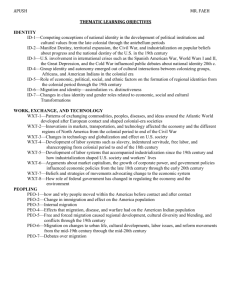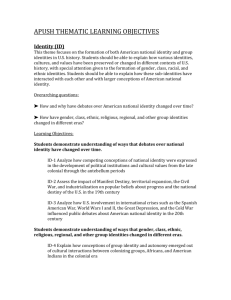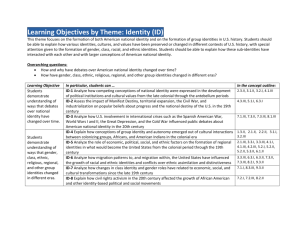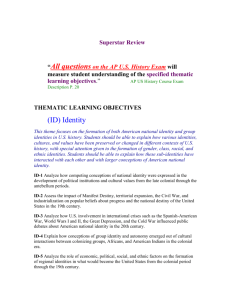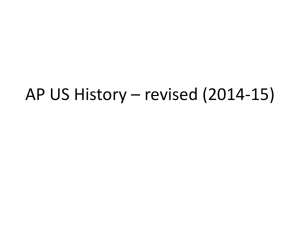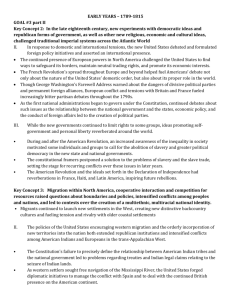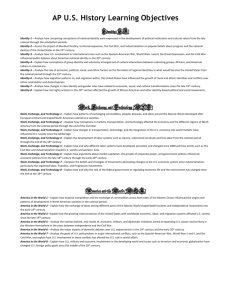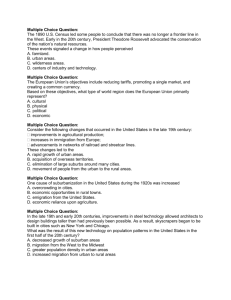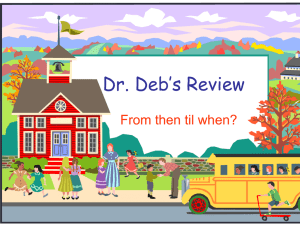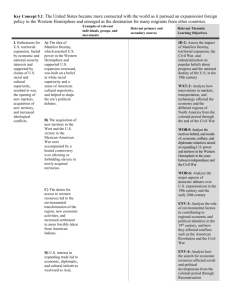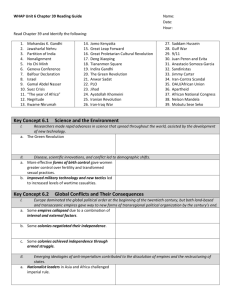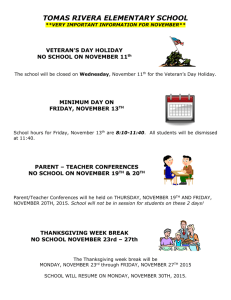Key Concepts and Themes
advertisement
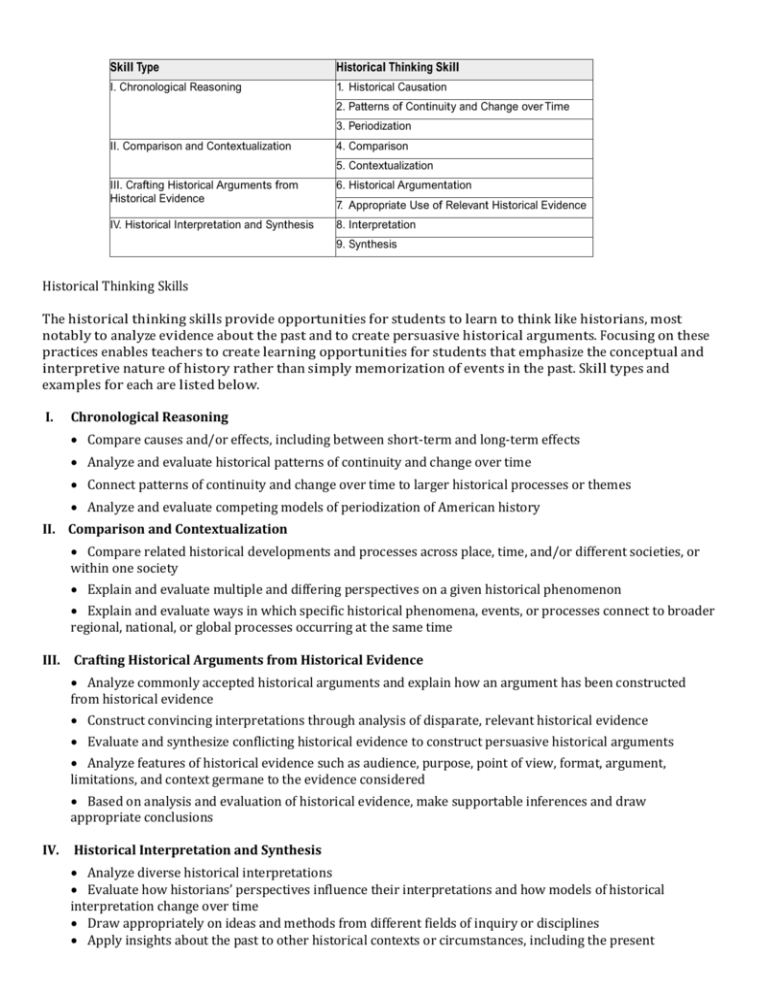
Skill Type Historical Thinking Skill I. Chronological Reasoning 1. Historical Causation 2. Patterns of Continuity and Change over Time 3. Periodization II. Comparison and Contextualization 4. Comparison 5. Contextualization III. Crafting Historical Arguments from Historical Evidence 6. Historical Argumentation IV. Historical Interpretation and Synthesis 8. Interpretation 7. Appropriate Use of Relevant Historical Evidence 9. Synthesis Historical Thinking Skills The historical thinking skills provide opportunities for students to learn to think like historians, most notably to analyze evidence about the past and to create persuasive historical arguments. Focusing on these practices enables teachers to create learning opportunities for students that emphasize the conceptual and interpretive nature of history rather than simply memorization of events in the past. Skill types and examples for each are listed below. I. Chronological Reasoning Compare causes and/or effects, including between short-term and long-term effects Analyze and evaluate historical patterns of continuity and change over time Connect patterns of continuity and change over time to larger historical processes or themes Analyze and evaluate competing models of periodization of American history II. Comparison and Contextualization Compare related historical developments and processes across place, time, and/or different societies, or within one society Explain and evaluate multiple and differing perspectives on a given historical phenomenon Explain and evaluate ways in which specific historical phenomena, events, or processes connect to broader regional, national, or global processes occurring at the same time III. Crafting Historical Arguments from Historical Evidence Analyze commonly accepted historical arguments and explain how an argument has been constructed from historical evidence Construct convincing interpretations through analysis of disparate, relevant historical evidence Evaluate and synthesize conflicting historical evidence to construct persuasive historical arguments Analyze features of historical evidence such as audience, purpose, point of view, format, argument, limitations, and context germane to the evidence considered Based on analysis and evaluation of historical evidence, make supportable inferences and draw appropriate conclusions IV. Historical Interpretation and Synthesis Analyze diverse historical interpretations Evaluate how historians’ perspectives influence their interpretations and how models of historical interpretation change over time Draw appropriately on ideas and methods from different fields of inquiry or disciplines Apply insights about the past to other historical contexts or circumstances, including the present AP United States History Course Content The AP U.S. History course is structured around themes and concepts in nine different chronological periods from approximately 1491 to the present: Within each period, key concepts organize and prioritize historical developments. Themes allow students to make connections and identify patterns and trends over time. Thematic Learning Objectives (Themes) ID — Identity WXT — Work, exchange, and technology PEO — Peopling POL — Politics and power WOR — America in the world ENV — Environment and geography — physical and human CUL — Ideas, beliefs, and culture Identity (ID) Overarching Question ID- 1-3: Key Concepts How and why have debates over American national identity changed over time? Objectives- Students will be: ID-1 Analyze how competing conceptions of national identity were expressed in the development of political institutions and cultural values from the late colonial through the antebellum periods 2.3., 3.1.II, 3.2.I, 4.1.III ID-2 Assess the impact of Manifest Destiny, territorial expansion, the Civil War, and industrialization on popular beliefs about progress and the national destiny of the United States in the 19th century ID-3 Analyze how U.S. involvement in international crises such as the Spanish-American War, World Wars I and II, the Great Depression, and the Cold War influenced public debates about American national identity in the 20th century. 4.1.III, 5.1.I, 5.3.III, 6.3.II Overarching Question for ID- 4-8: How have gender, class, ethnic, religious, Key Concepts 7.1.III, 7.3.II, 7.3.III, 8.1.III regional, and other group identities changed in different eras? Objectives- Students will be able : ID-4 Explain how conceptions of group identity and autonomy emerged out of cultural interactions between colonizing groups, Africans, and American Indians in the colonial era. 1.3.II, 2.1.II, 2.2.II, 3.1.I, 3.2.III ID-5 Analyze the role of economic, political, social, and ethnic factors on the formation of regional identities in what would become the United States from the colonial period through the 19th century. 2.1.III, 3.3.I, 3.3.III, 4.1.I, 4.1.III, 4.2.III, 5.2.I, 5.2.II, 5.3.II, 6.1.II ID-6 Analyze how migration patterns to, and migration within, the United States have influenced the growth of racial and ethnic identities and conflicts over ethnic assimilation and distinctiveness. 3.3.I, 4.2.III, 5.1.II, 6.2.I, 7.2.I, 7.2.II, 7.2.III, 7.3.III, 8.3.II, 9.3.II ID-7 Analyze how changes in class identity and gender roles have related to economic, social, and cultural transformations since the late 19th century. 7.1.I, 8.3.III, 9.3.II ID-8 Explain how civil rights activism in the 20th century affected the growth of African American and other identity-based political and social movements. 7.2.I,7.2.III, 8.2.I, 8.2.II Work, Exchange, and Technology (WXT) Overarching Question WXT- 1-3: How have changes in markets, transportation, and technology affected American society from colonial times to the present day? Objectives- Students will be able to : Key Concepts WXT-1 Explain how patterns of exchanging commodities, peoples, diseases, and ideas around the Atlantic World developed after European contact and shaped North American colonial-era societies. 1.2.I, 1.2.II, 2.2.I, 2.2.II, 2.3.I, 3.1.II WXT-2 Analyze how innovations in markets, transportation, and technology affected the economy and the different regions of North America from the colonial period through the end of the Civil War. 2.1.I, 2.1.III, 3.3.III, 4.2.I, 4.2.II, 4.2.III, 5.1.I WXT-3 Explain how changes in transportation, technology, and the integration of the U.S. economy into world markets have influenced U.S. society since the Gilded Age 6.1.I, 7.1.I, 7.2.I, 8.3.I, 9.3.I Overarching Question for WXT-4-5: Key Concepts Why have different labor systems developed in British North America and the United States, and how have they affected U.S. society? Objectives- Students will be: WXT-4 Explain the development of labor systems such as slavery, indentured servitude, and free labor from the colonial period through the end of the 18th century. 1.2.I, 2.1.II, 2.1.III, 2.3.I, 3.3.III WXT-5 Explain how and why different labor systems have developed, persisted, and changed since 1800 and how events such as the Civil War and industrialization shaped U.S. society and workers’ lives. 4.2.I, 4.2.II, 6.1.II, 6.1.III, 7.1.I, 7.2.I, 8.3.I Overarching Question for WXT- 6-8: How have debates over economic values and the role of Key Concepts government in the U.S. economy affected politics, society, the economy, and the environment? Objectives- Students will be: WXT-6 Explain how arguments about market capitalism, the growth of corporate power, and government policies influenced economic policies from the late 18th century through the early 20th century. 3.2.II, 4.2.II, 5.1.II, 6.1.I, 6.1.II, 7.1.II, 7.2.II WXT-7 Compare the beliefs and strategies of movements advocating changes to the U.S. economic system since industrialization, particularly the organized labor, Populist, and Progressive movements. 4.2.III, 6.1.II, 6.1.III, 7.1.II, 9.3.I WXT-8 Explain how and why the role of the federal government in regulating economic life and the environment has changed since the end of the 19th century 7.1.II, 7.1.III, 8.3.II, 9.1.II Peopling (PEO) Overarching Question PEO -1-3 Key Concepts Why have people migrated to, from, and within North America? Objectives- Students will be: PEO-1 Explain how and why people moved within the Americas (before contact) and to and within the Americas (after contact and colonization). 1.1.I, 2.1.I, 2.2.I PEO-2 Explain how changes in the numbers and sources of international migrants in the 19th and 20th centuries altered the ethnic and social makeup of the U.S. population. 4.2.II, 4.2.III, 5.1.II, 6.2.I, 7.2.II, 8.3.II, 9.3.II PEO-3 Analyze the causes and effects of major internal migration patterns such as urbanization, suburbanization, westward movement, and the Great Migration in the 19th and 20th centuries. 4.2.II, 4.2.III, 6.1.III, 6.2.I, 7.2.III, 8.3.I, 8.3.II, 9.3.II Overarching Question for PEO- 4-7: How have gender, class, ethnic, religious, Key Concepts regional, and other group identities changed in different eras? Objectives- Students will be able : PEO-4 Analyze the effects that migration, disease, and warfare had on the American Indian population after contact with Europeans 1.2.I, 2.2.II, 3.3.II, 6.2.II PEO-5 Explain how free and forced migration to and within different parts of North America caused regional development, cultural diversity and blending, and political and social conflicts through the 19th century. 1.2.I, 2.1.III, 2.2.II, 3.3.I, 5.1.II, 5.2.II, 6.1.III PEO-6 Analyze the role of both internal and international migration on changes to urban life, cultural developments, labor issues, and reform movements from the mid-19th century through the mid-20th century. 5.1.II, 6.1.II, 6.2.I, 7.2.II PEO-7 Explain how and why debates over immigration to the United States have changed since the turn of the 20th century. 7.2.II, 8.3.II, 9.3.II Politics and Power (POL) Overarching Question POL -1-4 Key Concepts How and why have different political and social groups competed for influence over society and government in what would become the United States? Objectives- Students will be: POL-1 Analyze the factors behind competition, cooperation, and conflict among different societies and social groups in North America during the colonial period. POL-2 Explain how and why major party systems and political alignments arose and have changed from the early Republic through the end of the 20th century. 1.2.II, 1.3.II, 2.1.II, 2.2.I, 2.2.II, 3.1.I, 3.1.II, 3.3.I, 3.3.II 3.1.III, 3.3.III, 4.1.I, 5.2.II, 7.1.III, 8.2.III POL-3 Explain how activist groups and reform movements, such as antebellum reformers, civil rights activists, and social conservatives, have caused changes to state institutions and U.S. society. 4.1.II, 5.2.I, 6.1.III, 6.2.I, 7.1.I, 7.1.II, 8.2.I, 8.2.II, 9.1.I POL-4 Analyze how and why the New Deal, the Great Society, and the modern conservative movement all sought to change the federal government’s role in U.S. political, social, and economic life. 7.1.III, 8.2.I, 9.1.II Overarching Question for POL- 5-7: How have Americans agreed on or argued Key Concepts over the values that guide the political system as well as who is a part of the political process? Objectives- Students will be able : POL-5 Analyze how arguments over the meaning and interpretation of the Constitution have affected U.S. politics since 1787. 3.2.I, 3.2.II, 3.2.III, 4.1.I, 5.2.I, 5.3.I, 5.3.II, 7.3.III, 8.2.III, 8.3.III POL-6 Analyze how debates over political values (such as democracy, freedom, and citizenship) and the extension of American ideals abroad contributed to the ideological clashes and military conflicts of the 19th century and the early 20th century. 4.1.I, 4.1.II, 4.3.II, 4.3.III, 5.1.II, 5.2.I, 5.2.II, 5.3.II, 5.3.III, 6.2.II, 6.3.I, 7.3.I, 7.3.II POL-7 Analyze how debates over civil rights and civil liberties have influenced political life from the early 20th century through the early 21st century. 7.2.II, 8.1.III, 8.2.I, 8.2.III, 9.2.II America in the World (WOR) Overarching Question WOR-1-4 Key Concepts How have events in North America and the United States related to contemporary developments in the rest of the world? Objectives- Students will be: WOR-1 Explain how imperial competition and the exchange of commodities across both sides of the Atlantic Ocean influenced the origins and patterns of development of North American societies in the colonial period. 1.2.I, 1.2.II, 2.1.I, 2.1.II, 2.2.I, 2.3.I, 2.3.II, 3.1.II, 3.3.I WOR-2 Explain how the exchange of ideas among different parts of the Atlantic World shaped belief systems and independence movements into the early 19th century. 2.3.I, 2.3.II, 3.2.I, 3.2.III, 4.1.II WOR-3 Explain how the growing interconnection of the United States with worldwide economic, labor, and migration systems affected U.S. society since the late 19th century. 6.1.I, 7.1.I, 8.1.II, 9.3.I WOR-4 Explain how the U.S. involvement in global conflicts in the 20th century set the stage for domestic social changes. 7.2.II, 7.2.III, 7.3.II, 7.3.III, 8.1.I, 8.1.II Overarching Question for WOR- 5-8: How have different factors influenced U.S. military, diplomatic, Key Concepts and economic involvement in international affairs and foreign conflicts, both in North America and overseas? Objectives- Students will be able : WOR-5 Analyze the motives behind, and results of, economic, military, and diplomatic initiatives aimed at expanding U.S. power and territory in the Western Hemisphere in the years between independence and the Civil War. 3.1.III, 3.2.II, 3.3.I, 3.3.II, 4.3.I, 5.1.I WOR-6 Analyze the major aspects of domestic debates over U.S. expansionism in the 19th century and the early 20th century. 4.3.I, 4.3.II, 5.1.I, 7.3.I WOR-7 Analyze the goals of U.S. policymakers in major international conflicts, such as the Spanish-American War, World 7.3.I, 7.3.II, 7.3.III, 8.1.I, 8.1.II, 9.2.I, 9.2.II Wars I and II, and the Cold War, and explain how U.S. involvement in these conflicts has altered the U.S. role in world affairs. WOR-8 Explain how U.S. military and economic involvement in the developing world and issues such as terrorism and economic globalization have changed U.S. foreign policy goals since the middle of the 20th century. 8.1.I, 8.1.II, 9.2.I, 9.2.II Environment and Geography –Human and Physical (ENV) Overarching Question ENV-1-3 Key Concepts How did interactions with the natural environment shape the institutions and values of various groups living on the North American continent? Objectives- Students will be: ENV-1 Explain how the introduction of new plants, animals, and technologies altered the natural environment of North America and affected interactions among various groups in the colonial period. 1.1.I, 1.2.I, 1.2.II, 2.2.I ENV-2 Explain how the natural environment contributed to the development of distinct regional group identities, institutions, and conflicts in the precontact period through the independence period. 1.1.I, 1.3.II, 2.1.III, 3.1.I ENV-3 Analyze the role of environmental factors in contributing to regional economic and political identities in the 19th century and how they affected conflicts such as the American Revolution and the Civil War. 3.3.III, 4.3.III, 5.1.I, 5.3.I Overarching Question for ENV-4-5: How did economic and demographic changes affect the Key Concepts environment and lead to debates over use and control of the environment and natural resources? Objectives- Students will be able : ENV-4 Analyze how the search for economic resources affected social and political developments from the colonial period through Reconstruction. .2.II, 2.1.I, 3.1.I, 5.1.I ENV-5 Explain how and why debates about and policies concerning the use of natural resources and the environment more generally have changed since the late 19th century. 6.1.III, 6.2.II, 7.1.II, 7.3.I, 8.1.II, 8.3.II, 9.3.I Ideas, Belief and Culture (CUL) Overarching Question CUL -1-3 Key Concepts How and why have moral, philosophical, and cultural values changed in what would become the United States? Objectives- Students will be: CUL-1 Compare the cultural values and attitudes of different European, African American, and native peoples in the colonial period and explain how contact affected intergroup relationships and conflicts. CUL-2 Analyze how emerging conceptions of national identity and democratic ideals shaped value systems, gender roles, and cultural movements in the late 18th century and the 19th century. 1.3.I, 1.3.II, 2.1.II, 2.2.II, 3.1.I 3.1.II, 3.2.III, 3.3.III, 4.1.II, 4.1.III, 5.2.I, 5.3.I CUL-3 Explain how cultural values and artistic expression changed in response to the Civil War and the postwar industrialization of the United States. 6.1.I, 6.3.II, 7.2.I Overarching Question for CUL- 4-7: How and why have changes in moral, philosophical, and cultural Key Concepts values affected U.S. history? Objectives- Students will be able : CUL-4 Analyze how changing religious ideals, Enlightenment beliefs, and republican thought shaped the politics, culture, and society of the colonial era through the early Republic. 2.1.III, 2.3.I, 2.3.II, 3.1.II, 3.2.I CUL-5 Analyze ways that philosophical, moral, and scientific ideas were used to defend and challenge the dominant economic and social order in the 19th and 20th centuries. 4.1.III, 6.1.I, 6.3.II, 7.1.II, 7.1.III, 8.1.III, 8.3.I CUL-6 Analyze the role of culture and the arts in 19th- and 20th-century movements for social and political change. 5.2.I, 6.3.II, 7.2.I, 8.3.I, 8.3.III CUL-7 Explain how and why “modern” cultural values and popular culture have grown since the early 20th century and how they have affected American politics and society. 7.2.I, 8.3.I, 8.3.III, 9.3.I Key Concepts PERIOD 1: 1491–1607: On a North American continent controlled by American Indians, contact among the peoples of Europe, the Americas, and West Africa created a new world. Key Concept 1.1: Before the arrival of Europeans, native populations in North America developed a wide variety of social, political, and economic structures based in part on interactions with the environment and each other. Key Concept 1.2: European overseas expansion resulted in the Columbian Exchange, a series of interactions and adaptations among societies across the Atlantic Key Concept 1.3: Contacts among American Indians, Africans, and Europeans challenged the worldviews of each group PERIOD 2: 1607–1754: Europeans and American Indians maneuvered and fought for dominance, control, and security in North America, and distinctive colonial and native societies emerged. Key Concept 2.1: Differences in imperial goals, cultures, and the North American environments that different empires confronted led Europeans to develop diverse patterns of colonization. Key Concept 2.2: European colonization efforts in North America stimulated intercultural contact and intensified conflict between the various groups of colonizers and native peoples. Key Concept 2.3: The increasing political, economic, and cultural exchanges within the “Atlantic World” had a profound impact on the development of colonial societies in North America. PERIOD 3: 1754–1800: British imperial attempts to reassert control over its colonies and the colonial reaction to these attempts produced a new American republic, along with struggles over the new nation’s social, political, and economic identity. Key Concept 3.1: Britain’s victory over France in the imperial struggle for North America led to new conflicts among the British government, the North American colonists, and American Indians, culminating in the creation of a new nation, the United States. Key Concept 3.2: In the late 18th century, new experiments with democratic ideas and republican forms of government, as well as other new religious, economic, and cultural ideas, challenged traditional imperial systems across the Atlantic World. Key Concept 3.3: Migration within North America, cooperative interaction, and competition for resources raised questions about boundaries and policies, intensified conflicts among peoples and nations, and led to contests over the creation of a multiethnic, multiracial national identity. PERIOD 4: 1800–1848: The new republic struggled to define and extend democratic ideals in the face of rapid economic, territorial, and demographic changes. Key Concept 4.1: The United States developed the world’s first modern mass democracy and celebrated a new national culture, while Americans sought to define the nation’s democratic ideals and to reform its institutions to match them. Key Concept 4.2: Developments in technology, agriculture, and commerce precipitated profound changes in U.S. settlement patterns, regional identities, gender and family relations, political power, and distribution of consumer goods. Key Concept 4.3: U.S. interest in increasing foreign trade, expanding its national borders, and isolating itself fromEuropean conflicts shaped the nation’s foreign policy and spurred government and private initiatives. PERIOD 5: 1844–1877: As the nation expanded and its population grew, regional tensions, especially over slavery, led to a civil war — the course and aftermath of which transformed American society. Key Concept 5.1: The United States became more connected with the world as it pursued an expansionist foreign policy in the Western Hemisphere and emerged as the destination for many migrants from other countries. Key Concept 5.2: Intensified by expansion and deepening regional divisions, debates over slavery and other economic, cultural and political issues led the nation into civil war. Key Concept 5.3: The Union victory in the Civil War and the contested Reconstruction of the South settled the issues of slavery and secession, but left unresolved many questions about federal government power and citizenship rights. PERIOD 6: 1865–1898: The transformation of the United States from an agricultural to an increasingly industrialized and urbanized society brought about significant economic, political, diplomatic, social, environmental, and cultural changes. Key Concept 6.1: The rise of big business in the United States encouraged massive migrations and urbanization, sparked government and popular efforts to reshape the U.S. economy and environment, and renewed debates over U.S. national identity. Key Concept 6.2: The rise of big business and an industrial culture in the United States led to both greater opportunities for and restrictions on immigrants, minorities, and women. Key Concept 6.3: The “Gilded Age” witnessed new cultural and intellectual movements in tandem with political debates over economic and social policies. PERIOD 7: 1890–1945: An increasingly pluralistic United States faced profound domestic and global challenges, debated the proper degree of government activism, and sought to define its international role. Key Concept 7.1: Government, political and social organizations struggled to address the effects of large-scale industrialization, economic uncertainty, and related social changes such as urbanization and mass migration. Key Concept 7.2: A revolution in communications and transportation technology helped to create a new mass culture and spread “modern” values and ideas, even as cultural conflict between groups increased under the pressure of migration, world wars, and economic distress. Key Concept 7.3: Global conflicts over resources, territories and ideologies renewed debates over the nation’s values and its role in the world, while simultaneously propelling the United States into a dominant international military, political, cultural, and economic position. PERIOD 8: 1945–1980: After World War II, the United States grappled with prosperity and unfamiliar international responsibilities while struggling to live up to its ideals. Key Concept 8.1: The United States responded to an uncertain and unstable postwar world by asserting and attempting to defend a position of global leadership, with far-reaching domestic and international consequences. Key Concept 8.2: Liberalism, based on anticommunism abroad and a firm belief in the efficacy of governmental and especially federal power to achieve social goals at home, reached its apex in the mid-1960s and generated a variety of political and cultural responses. Key Concept 8.3: Postwar economic, demographic and technological changes had far-reaching impacts on American society, politics, and the environment PERIOD 9: 1980–Present: As the United States transitioned to a new century filled with challenges and possibilities, it experienced renewed ideological and cultural debates, sought to redefine its foreign policy, and adapted to economic globalization and revolutionary changes in science and technology. Key Concept 9.1: A new conservatism grew to prominence in U.S. culture and politics, defending traditional social values and rejecting liberal views about the role of government. Key Concept 9.2: The end of the Cold War and new challenges to U.S. leadership in the world forced the nation to redefine its foreign policy and global role. Key Concept 9.3: Moving into the 21st century, the nation continued to experience challenges stemming from social, economic and demographic changes.
